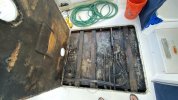Hello,
We just got a 1996 Marlin 30 that needs a little love, so this will be the first of many stupid questions that I will ask!
The Bulkhead/spacer that is between the two fuel tanks is totally disintegrated. (It is the thin board between my feet in the photo below.) It is glassed in to the stringers on the sides, but doesn't appear to be structural. It also does not appear to be in contact with any other wood.
I am sure it is there for a reason, but should I be worried about it?

Thanks for your input.
We just got a 1996 Marlin 30 that needs a little love, so this will be the first of many stupid questions that I will ask!
The Bulkhead/spacer that is between the two fuel tanks is totally disintegrated. (It is the thin board between my feet in the photo below.) It is glassed in to the stringers on the sides, but doesn't appear to be structural. It also does not appear to be in contact with any other wood.
I am sure it is there for a reason, but should I be worried about it?

Thanks for your input.

